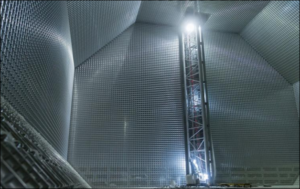Maritime Sector is Set to Become ‘Ammonia-Ready’
By Stephen H. Crolius on February 18, 2021
Last month brought news of “the world’s first ammonia ready vessel.” According to an American Bureau of Shipping (ABS) press release, the vessel, currently under construction in China, will comply “with the ABS Ammonia Ready Level 1 requirements, indicating it is designed to be converted to run on ammonia in the future.” When completed, the 274-meter ship (and possibly two others of identical design) will join the fleet of Avin International. Avin, with headquarters in Greece, describes itself as “a major tanker operator, active in the shipment of crude oil and petroleum products.”

“Ammonia-ready vessel.” The term has a short pedigree. It seems to have first arrived in public discourse in a December 2020 press release from Wärtsilä Marine Power headlined “What does an ammonia-ready vessel look like?” In considering this question, Wärtsilä starts by suggesting that ammonia will be taken up as a bunker fuel in a multi-step process rather than with the simple flip of a switch. Wärtsilä envisions an initial use case with ammonia as a co-fuel in a diesel engine. In this scenario, according to Wärtsilä Marine Power’s General Manager of Fuel & Operational Flexibility, Kaj Portin, the evolutionary path would involve “moving from a diesel engine with ammonia capabilities to an engine that is more optimised for ammonia.”
The press release continues:
Combustion tests have already shown that ammonia can be used as a drop-in fuel with diesel. But this is in a laboratory setting. For real-world engines, ammonia requires extra safety precautions and new materials. Nickle and copper found in seals, gaskets, valves and electrical components would corrode quickly once exposed to ammonia, for example, as would most elastomers used in today’s engineering.
Wärtsilä Marine Power, “What does an ammonia-ready vessel look like?”, December 1, 2020
ABS is a prominent maritime classification society. It designated the Avin ship as ammonia-ready based on its conformance with requirements outlined in ABS’s Guide for Gas and Other Low-Flashpoint Fuel Ready Vessels, which was released in November 2020. According to the ABS website, the publication “provides guidance on available technologies, regulatory requirements and installation and operational considerations for adopting gas or other low flash point fuels.” (It does not mention ammonia-readiness as a distinct regulatory classification.)

The ammonia-ready vessel already has a counterpart on the fuel supply side. In December 2020, the EPC firm Black & Veatch released Hybrid LNG & Ammonia Infrastructure: Key to a Green Economy, a report that presents the concept of the ammonia-ready LNG port terminal. Here differences in physical properties (boiling point; density) lead to different designs for tanks and pumps. Substitutions for the sake of material compatibility also figure in the B&V designs. When all factors are taken into account, B&V estimates that achieving ammonia-readiness will add 6.5 to 11.5 percent to the capital cost of a new LNG terminal (almost half the comparative 11.0 to 20.0 percent cost of converting an existing terminal from LNG to ammonia).
The ammonia-ready vessel concept got one more checkmark this week from Gaztransport & Technigaz (GTT), a French company which bills itself as an “engineering company in containment systems for transport and storage of LNG.” On Monday, Bureau Veritas announced that it has given GTT’s Mark III membrane tank an “NH3 Ready” classification. According to the Bureau Veritas press release, “the AiP [approval in principle] recognizes that the Mark III system, without any major design changes, is suitable for the subsequent containment of ammonia in LNG as fuel applications.”
Now that it is here, the ammonia-ready concept seems likely to play a key role in processes of ammonia energy implementation – in the maritime sector and many sectors beyond. One pictures a generation of long-lived assets that start out as one thing, and by the end of their useful lives have become another – much more climate-friendly – thing altogether.